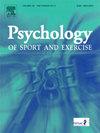Contextual and affective precursors of physical activity intention and enactment examined through ecological momentary assessment
IF 3.1
2区 心理学
Q2 HOSPITALITY, LEISURE, SPORT & TOURISM
引用次数: 0
Abstract
Background
Regular physical activity (PA) provides numerous health benefits, which is why many people intend to lead an active lifestyle. Yet, internal and external states and barriers can hinder the translation of such intentions into actual behavior. This study prospectively studied such barriers, namely, the temporal relationship between the independent variables momentary affect (stress, emotions), and the dependent variables PA intentions and subsequent PA behavior. The variables were measured using Ecological Momentary Assessment (EMA) at the within-person level.
Methods
A total of 41 healthy participants (aged 19–67) completed 4 daily EMA prompts over three weeks on their smartphones, capturing data on momentary affective states (happy, active, irritated, tired, concerned, nervous, relaxed, energetic), anticipated contextual barriers (i.e., PA-incompatible external circumstances), prospective PA intentions, and PA behavior (retrospective, since the last prompt). We applied generalized linear mixed effect models to examine the influence of momentary affect and contextual barriers onto a) PA intentions, b) their consecutive enactment, and c) directly onto PA behavior.
Results
Individuals were more likely to form PA intentions when feeling happy, active, or energetic, but less likely when external/contextual barriers were high or when they felt tired. Furthermore, only PA intentions were significant precursors of subsequent PA behavior, while neither contextual barriers, nor momentary affect directly affected PA behavior.
Conclusions
Interventions for fostering PA, such as Just-in-Time Adaptive Interventions, should address and ‘stabilize’ intentions through addressing external barriers and positive affects (happy, active, energetic). The present results call for more temporally sensitive and dynamic health behavior theories of PA.
通过生态瞬时评估研究体育活动意图和行为的情境和情感前驱。
背景:有规律的体育活动(PA)对健康有很多好处,这就是为什么许多人打算过一种积极的生活方式。然而,内部和外部的状态和障碍会阻碍这种意图转化为实际行为。本研究前瞻性地研究了这些障碍,即自变量瞬时情感(压力、情绪)与因变量PA意图和随后的PA行为之间的时间关系。使用生态瞬时评估(EMA)在个人水平上测量变量。方法:共有41名健康参与者(年龄19-67岁)在三周内通过智能手机完成了4个每日EMA提示,捕捉瞬间情感状态(快乐、活跃、烦躁、疲倦、关注、紧张、放松、精力)、预期情境障碍(即PA不相容的外部环境)、预期PA意图和PA行为(回顾,自上次提示开始)的数据。我们应用广义线性混合效应模型来研究瞬时情感和情境障碍对以下因素的影响:a)行为动机,b)行为动机的连续实施,以及c)行为动机的直接影响。结果:当个人感到快乐、积极或精力充沛时,他们更有可能形成PA意图,但当外部/环境障碍很高或他们感到疲倦时,他们不太可能形成PA意图。此外,只有PA意向是后续PA行为的显著前驱,而情境障碍和瞬间影响都没有直接影响PA行为。结论:培养PA的干预措施,如即时适应性干预,应该通过解决外部障碍和积极影响(快乐、积极、精力充沛)来解决和“稳定”意图。目前的结果需要更多的时间敏感和动态健康行为理论的PA。
本文章由计算机程序翻译,如有差异,请以英文原文为准。
求助全文
约1分钟内获得全文
求助全文
来源期刊
CiteScore
6.40
自引率
5.90%
发文量
172
审稿时长
69 days
期刊介绍:
Psychology of Sport and Exercise is an international forum for scholarly reports in the psychology of sport and exercise, broadly defined. The journal is open to the use of diverse methodological approaches. Manuscripts that will be considered for publication will present results from high quality empirical research, systematic reviews, meta-analyses, commentaries concerning already published PSE papers or topics of general interest for PSE readers, protocol papers for trials, and reports of professional practice (which will need to demonstrate academic rigour and go beyond mere description). The CONSORT guidelines consort-statement need to be followed for protocol papers for trials; authors should present a flow diagramme and attach with their cover letter the CONSORT checklist. For meta-analysis, the PRISMA prisma-statement guidelines should be followed; authors should present a flow diagramme and attach with their cover letter the PRISMA checklist. For systematic reviews it is recommended that the PRISMA guidelines are followed, although it is not compulsory. Authors interested in submitting replications of published studies need to contact the Editors-in-Chief before they start their replication. We are not interested in manuscripts that aim to test the psychometric properties of an existing scale from English to another language, unless new validation methods are used which address previously unanswered research questions.

 求助内容:
求助内容: 应助结果提醒方式:
应助结果提醒方式:


